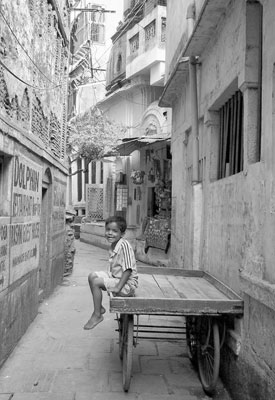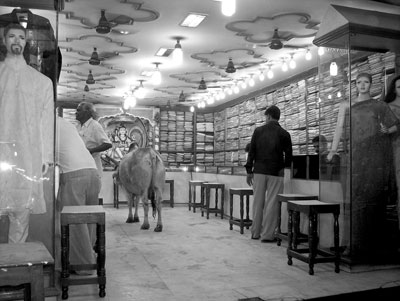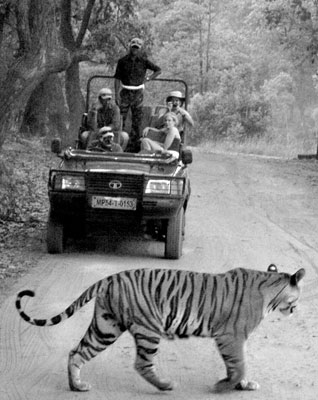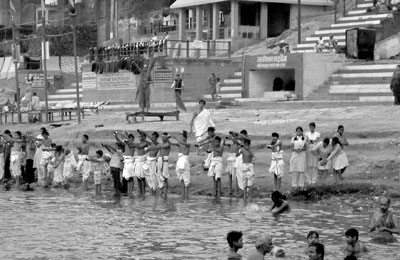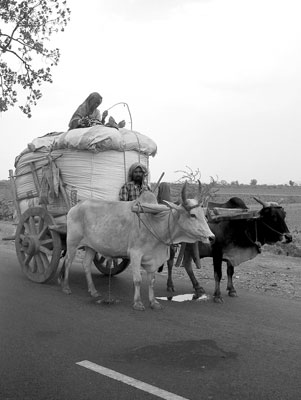Central India’s diverse treasures
This item appears on page 86 of the November 2008 issue.
Part 3 of 4 on India & Nepal
It is an impossible task to convey in these few pages any real detail concerning the numerous varied attractions of the four distinct destinations in central India that are the subject of this column. My goal, instead, shall be to convey essence and hopefully inspire readers to further explore this important region.
I will proceed in the order of my visitations during a May 2008 individual tour of India and Nepal hosted by SITA World Tours (Encino, CA; 800/421-5643, www.sitatour.com).
Agra and the Taj Mahal
Driving from Jaipur to Agra, I stopped to explore the abandoned 16th-century Mughal City of Fatehpur Sikri, constructed primarily of red sandstone and best described as a masterpiece of Jain, Muslim and Hindu architecture.
This is where I met my newest guide, Gurudayal, who traveled on with me to Agra. He advised that a shortage of water was the main reason the city was later abandoned.
Unlike many of the prime destinations I visited in India, Agra (the last capital of the Mughal Empire) and particularly the Agra Fort and the Taj Mahal did not seem to have much of an off-season in terms of visitor crowds. What was different was that a majority of visitors to Agra during the hot off-season were Indians, not foreigners.
The huge, 16th-century Agra Fort, built by the famous Mughal emperor Akbar, includes the visually stunning Pearl Mosque among its many notable structures. It was the perfect prelude to my exploration of India’s most famous structure.
The famed 17th-century Taj Mahal’s white marble symmetry and imposing Mughal design did not disappoint, especially in the changing hues of late afternoon. It was most enjoyable being able to tour the grounds at leisure — a luxury not commonly afforded with comprehensive tour schedules.
I strained to imagine 20,000 workers laboring for 22 years to construct this architectural treasure of the ages.
My single overnight in Agra was at the luxurious Oberoi Amarvilas, arguably the best and best-located property in Agra, where all rooms offer unobstructed private views of the Taj Mahal in all her changing moods.
The Amarvilas, built in a style inspired by Mughal and Moorish architecture, left absolutely nothing to be desired in terms of amenities and service. Its fountains, pools, pavilions and terraced lawns and gardens transport one back to royal times past.
Khajuraho and temple erotica
My early-morning departure from Agra was by train to Jhansi. On arrival, I transferred to a vehicle, then toured the mostly Mughal-style medieval city of Orchha, whose 16th- and 17th-century temples and palaces have survived the ravages of time remarkably well. After lunch, I continued by road for nearly five hours to Khajuraho.
Khajuraho was small (pop. 15,000), peaceful and relaxing — a welcome contrast to the crowds in Agra and the Taj Mahal.
My local guide, Dhirendra, seemed to be an expert on local temple construction, unveiling great details of the history of the area, which dates from the eighth century.
Only 25 of the original 85 temples in the area remain today. The main temple complex fell into disrepair in centuries past and was covered by vegetation, only to be rediscovered by English explorers in 1864.
Khajuraho’s western group of temples is the best preserved, featuring Kandariya Mahadev Temple with its 100-foot-high spire and range of erotic carvings.
Many of the carvings are like a detailed video of local life at the time of their origination. The philosophy behind the often-explicit carvings is that one must be physically fulfilled so the mind will not be diverted from spiritual pursuits. Hmmm. Would this in any way account for both the size and generally spiritual nature of India’s population today?
My abode in Khajuraho was the Grand Temple View Hotel, which featured expansive temple views and an evening sound-and-light program showcasing the vibrant history of Khajuraho. At the hotel, I also enjoyed fine dining, outstanding service and a large spa with very reasonable prices.
Bandhavgarh National Park and Mahua Kothi
A 4-hour road journey the following morning transported me to a very different world. For the next few days, my state of consciousness would be ensconced in India’s natural world, far from the distractions of civilization.
My experience at Mahua Kothi Game Lodge in Bandhavgarh National Park would trigger many fond memories of past adventures in the game parks of Africa.
While Mahua Kothi and Bandhavgarh provide opportunities to experience the full array of resident wildlife, most visitors clearly venture to this isolated destination to see tigers in the wild. It’s one of the few remaining places on the planet where it is possible to do so.
The two days and nights I spent at Mahua Kothi were filled with game drives in open-air vehicles and abundant leisure time enjoying the facilities at the lodge. Lounging at the ultra-inviting lodge pool offered welcome respite from the oppressive midday sun.
The evening meals were a special experience, one in an open setting overlooking adjoining grasslands and the second on the lodge rooftop, from where the sea of stars in the clear night skies seemed close enough to reach out and touch. The manager’s knowledge of astronomy and a special telescope accented the evening.
Lunch and dinner at Mahua Kothi featured tasty, healthy Indian cuisine, and the chef was happy to accommodate guests’ special requests.
Each of Mahua Kothi’s 12 freestanding, jungle-hut-style guest suites are accessed through private courtyards with lounging areas. The interiors each have a wonderful natural feel, utilizing local woods, rock and fabrics in much the same manner as better African game lodges but with definite Indian accents. The suites are spacious, supremely comfortable and seemingly user-friendly in all regards.
A lodge assistant or butler was on call 24/7 for any special requirements.
Tigermania
It is accurate to say that game drives in Bandavgarh tend to focus strongly on spotting tigers — as close up as possible, of course. In that regard, we were able to see four tigers during my three game drives, including one that, to our good fortune, passed only 30 feet behind our vehicle.
We were blessed to have as our guide Durgesh Singh, a true naturalist who refused to allow us to become over-focused on tigers to the exclusion of other wildlife. Therefore, we also observed a wide range of bird species and other animals and reptiles, including spotted deer (abundant), wild boars, sambar, a mongoose, monitor lizards and both red- and black-faced monkeys.
Varanasi
The Hindu pilgrimage destination of Varanasi is India’s holiest city, located on the banks of the sacred Ganges. From elaborate evening prayer services to cremation ceremonies, Varanasi tends to bring into play a full palate of human emotions.
Upon my arrival from Khajuraho on an early-afternoon flight, my new guide, Raj, and I visited nearby Sarnath, the site of Buddha’s first sermon and an important pilgrimage site for Buddhists worldwide.
We first explored a Buddhist museum and then the many stupas and shrines that grace the grounds. Clearly, many presumably Buddhist visitors were moved by being in such a hallowed Buddhist setting.
Evening prayers pilgrimage
In the evening, we undertook a pilgrimage on foot through the narrow streets of the Old City to attend the nightly prayer services on the banks of the Ganges.
On arrival, I was able to view the colorful ceremonial services from the balcony of a local restaurant high above the crowded, compacted fray. We walked to and from the ceremony, but a rickshaw ride definitely would be a better choice for most, thereby avoiding the jostling discomfort of the very crowded streets.
Certainly, I had by this time learned that one can see just about anything on the animal-and-human-shared streets of India. While that evening I did not observe the proverbial bull in a china shop, amazingly I did see a Brahma bull inside a nice fabric store, waiting (for what, I have no idea) patiently like several customers, and I have the photo to prove it.
The space tolerance of humans toward animals in India absolutely defies description — a comment which I make with completely complimentary intention. Perhaps this results from a culture in which most humans (like myself, coincidentally or not) do not regard any other animal as a food source.
Sunrise Ganges cruise
A sunrise cruise on the Ganges unveiled a feast for the senses, a true microcosm of life along the sacred river.
We observed Hindus by the hundreds paying homage to the Sun God and throngs of students practicing morning yoga. A labyrinth of colors, aromas and sounds enveloped the banks, swelling the senses.
We passed ghats where scores of pilgrims were bathing in the holy waters plus burning ghats where cremations were being conducted by soulful relatives. The combining of myriad fragrances was an unfamiliar smoky sweet on the nose.
I had arranged for time to meditate in this sacred setting, and Raj and the boat guide left me for a generous while to contemplate in peace on the opposite shore.
The morning cruise was followed by a walking tour through the narrow streets and alleyways of the Old City, which proved to be both fascinating and a test of sensibilities.
The mystical morning along the Ganges, the city of Varanasi and India as a whole had left me with an overwhelming feeling of pure gratitude for the generous life fate I had been afforded.
In next month’s column I will describe departing India for a 3-day Nepal excursion.
Keck's Beyond the Garden Wall
❝ Of palatial wonderment
at once ancient and ageless
Of great striped beasts
proud, fragile, few
Of final earthly journeys
that shed the human form to rise anew. ❞
— Randy on his highly reflective journey through central India

